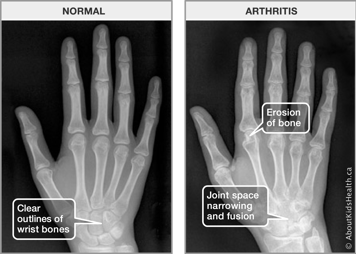It is important to remember that JIA is not contagious. It is also not known for certain what the exact cause is. In JIA, the immune system is not working normally. The immune system's job is to fight off germs and disease. However, in JIA, the immune system attacks healthy joints, causing inflammation.
Joint inflammation in JIA
In JIA, the immune system does not work normally. The immune system’s job is to protect the body by fighting off germs and disease. However, in JIA, the immune system works against the body by attacking healthy joints, causing inflammation.
To learn more about what happens when your joints become inflamed, click through the joint inflammation animation.
If the inflammation of JIA is not treated, it can lead to permanent damage of your joint. Damage occurs because the inflammation attacks the cartilage and bone. This can cause loss of cartilage, which leads to narrowing of the space between the bones. This in turn causes a loss of the protective cushioning that the cartilage provides, which can result in pain, stiffness and difficulty moving the joint.
Inflammation can “eat into” bones, causing damaged areas, or erosions, where the bone wears out. We can see erosions on X-rays or MRI tests. Once this type of joint damage occurs, it usually cannot be reversed with medications.
See if you can find the erosions on the X-rays below.

Signs of JIA
Look at one of your own joints. Can you see or feel any of the following five signs of inflammation?
- Redness
- Swelling
- Heat or warmth
- Pain or tenderness when squeezing or moving the joint
- Difficulty moving your joint (stiffness).
Flares and remissions
When your joint becomes inflamed, you may have one or all of the above symptoms. If your inflammation gets worse, it is called a flare, or flare-up. If the inflammation in your joints goes away (and you no longer have signs and symptoms of JIA), it is called a remission.
You may have day-to-day changes in symptoms but that does not mean you are having a flare-up of your JIA. For example, one morning you may find your joints stiff and sore. The next day you may have no morning stiffness or pain. A flare is when you have an increase in inflammation for a prolonged period of time, lasting longer than just a few days.






